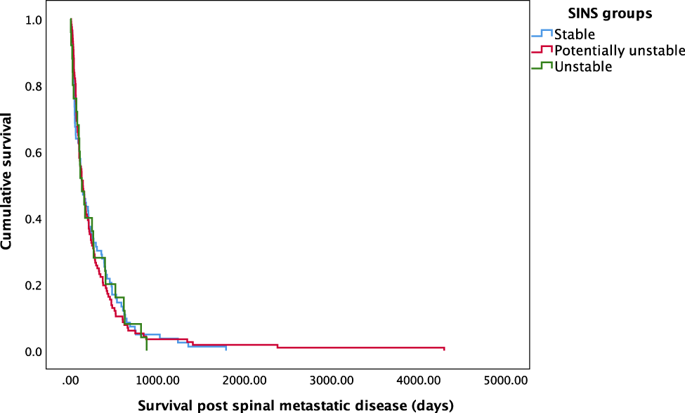当前位置:
X-MOL 学术
›
Spinal Cord
›
论文详情
Our official English website, www.x-mol.net, welcomes your feedback! (Note: you will need to create a separate account there.)
The clinical utility of the Spinal Instability Neoplastic Score (SINS) system in spinal epidural metastases: a retrospective study.
Spinal Cord ( IF 2.2 ) Pub Date : 2020-02-11 , DOI: 10.1038/s41393-020-0432-8 Ayoub Dakson 1 , Erika Leck 1 , David M Brandman 1 , Sean D Christie 1
Spinal Cord ( IF 2.2 ) Pub Date : 2020-02-11 , DOI: 10.1038/s41393-020-0432-8 Ayoub Dakson 1 , Erika Leck 1 , David M Brandman 1 , Sean D Christie 1
Affiliation

|
STUDY DESIGN
A retrospective study.
OBJECTIVES
This study assessed the clinical utility of the Spinal Instability Neoplastic Score (SINS) in relation to the surgical treatment of spinal epidural metastasis and factors important for surgical decision-making. These factors include epidural spinal cord compression (ESCC), patient prognosis and neurologic status.
SETTING
Queen Elizabeth II Health Sciences Centre, Halifax, Canada.
METHODS
We identified 285 patients with spinal metastatic disease. Data were extracted through a retrospective review. SINS and ESCC were scored based on CT and MRI, respectively.
RESULTS
Patients were grouped into stable (35%), potentially unstable (52%), and unstable (13%) groups. The overall incidence of metastatic spinal deformity was 9%. Surgical interventions were performed in 21% of patients, including decompression and instrumented fusion (70%), decompression alone (17%), percutaneous vertebral augmentation (9%), and instrumented vertebral augmentation (5%). The use of spinal instrumentation was significantly associated with unstable SINS (p = 0.005). Grade 3 ESCC was also significantly associated with unstable SINS (p < 0.001). Kaplan-Meier analysis revealed that SINS was not a predictor of survival (p = 0.98). In the radiotherapy-alone group, a significant proportion of patients with potentially unstable SINS (30%) progressed into unstable SINS category at an average 364 ± 244 days (p < 0.001).
CONCLUSION
This study demonstrated that more severe categories of SINS were associated with higher degrees of ESCC, and surgical interventions were more often utilized in this group with more frequent placement of spinal instrumentation. Although SINS did not predict patient prognosis, it correlates with the progression of metastatic instability in patients treated with radiotherapy.
中文翻译:

脊柱硬膜外转移中脊柱不稳定肿瘤评分系统的临床应用:一项回顾性研究。
研究设计回顾性研究。目的本研究评估了脊柱不稳性肿瘤评分(SINS)与脊柱硬膜外转移的外科治疗及对外科决策重要的因素的临床应用。这些因素包括硬膜外脊髓压迫(ESCC),患者的预后和神经系统状态。地点加拿大哈利法克斯的伊丽莎白二世女王健康科学中心。方法我们确定了285例脊柱转移性疾病患者。通过回顾性回顾提取数据。SINS和ESCC分别基于CT和MRI进行评分。结果将患者分为稳定(35%),潜在不稳定(52%)和不稳定(13%)组。转移性脊柱畸形的总发生率为9%。在21%的患者中进行了手术干预,包括减压和器械融合(70%),单独减压(17%),经皮椎体扩张(9%)和器械椎体扩张(5%)。脊柱器械的使用与不稳定的SINS显着相关(p = 0.005)。3级ESCC也与不稳定的SINS显着相关(p <0.001)。Kaplan-Meier分析表明,SINS不能预测生存(p = 0.98)。在单纯放疗组中,相当大比例的潜在不稳定SINS患者(30%)平均在364±244天发展为不稳定SINS类型(p <0.001)。结论这项研究表明,较严重的SINS类别与较高的ESCC相关,在这一组中,外科手术干预更多,脊柱器械的放置频率更高。尽管SINS不能预测患者的预后,但它与接受放射治疗的患者转移不稳定的进展有关。
更新日期:2020-02-11
中文翻译:

脊柱硬膜外转移中脊柱不稳定肿瘤评分系统的临床应用:一项回顾性研究。
研究设计回顾性研究。目的本研究评估了脊柱不稳性肿瘤评分(SINS)与脊柱硬膜外转移的外科治疗及对外科决策重要的因素的临床应用。这些因素包括硬膜外脊髓压迫(ESCC),患者的预后和神经系统状态。地点加拿大哈利法克斯的伊丽莎白二世女王健康科学中心。方法我们确定了285例脊柱转移性疾病患者。通过回顾性回顾提取数据。SINS和ESCC分别基于CT和MRI进行评分。结果将患者分为稳定(35%),潜在不稳定(52%)和不稳定(13%)组。转移性脊柱畸形的总发生率为9%。在21%的患者中进行了手术干预,包括减压和器械融合(70%),单独减压(17%),经皮椎体扩张(9%)和器械椎体扩张(5%)。脊柱器械的使用与不稳定的SINS显着相关(p = 0.005)。3级ESCC也与不稳定的SINS显着相关(p <0.001)。Kaplan-Meier分析表明,SINS不能预测生存(p = 0.98)。在单纯放疗组中,相当大比例的潜在不稳定SINS患者(30%)平均在364±244天发展为不稳定SINS类型(p <0.001)。结论这项研究表明,较严重的SINS类别与较高的ESCC相关,在这一组中,外科手术干预更多,脊柱器械的放置频率更高。尽管SINS不能预测患者的预后,但它与接受放射治疗的患者转移不稳定的进展有关。


























 京公网安备 11010802027423号
京公网安备 11010802027423号